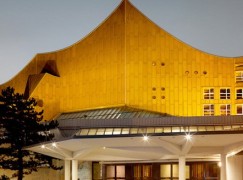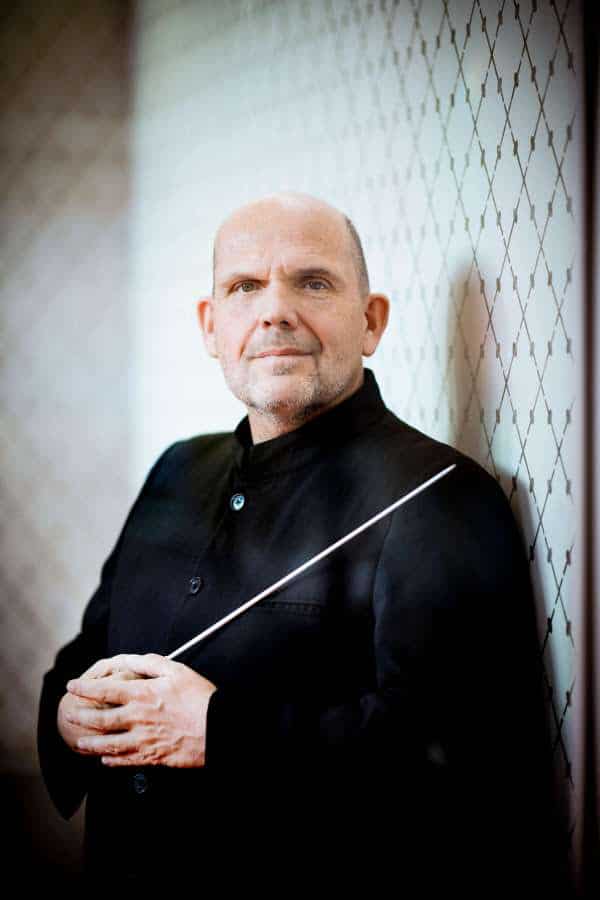Berlin pays $100 a night for your seat at the Philharmonic
OrchestrasSome fascinating stats on public subsidies in BZ-Berlin.
A sampling:
Berliner Philharmoniker: Audience: 241,730, occupancy/seat: 86.4%, ticket revenue: 55.20 euros per seat, subsidy per seat: 110.10 euros, subsidy share: 50%, performances 133
Konzerthaus: Audience 139,585, occupancy: 79.9%, ticket revenue: 26.50 euros, subsidy: 154.10 euros, subsidy share: 73.6%, performances: 283
Staatsoper Unter den Linden: Audience: 232,963, occupancy/seat: 81.6%, ticket revenue: 55.40 euros, subsidy per seat: 255.80 euros, subsidy share: 78%.
Deutsche Oper: Audience: 243,649, Occupancy/seat: 66.4 %, earnings per seat: 35 Euros, subsidy per seat: 216 Euros, subsidy share 80.4 %,.
More here






Bravo! Thank you, Berlin!
Kind of sad that they have to pay people to listen to music, and millions of people pay hundreds of dollars to scream at a Taylor Swift concert.
Not really how it works. I suppose the Berlin Philharmonic could charge 165 Euros per seat, but chances are their occupancy rate would fall a bit.
People may pay a lot to hear Taylor Swift in live performance, but for many it’s a once-in-a-lifetime experience. Not a dozen times a year.
As long as you have 100 musicians performing for only 2500 people, it’s probably going to require subsidy if it’s going to be affordable to average people.
17th and 18th century opera virtuosos and castrati used to elicit similar behavior from their fans. And as recently as 1990’s Three Tenors concerts.
Which begs the question- how musically literate are today’s pop singers? Can they read opera and orchestral music scores?
Thielemann better play it cordially with the state government this time, in sight of these numbers. Don’t bite the hand that feeds you too much.
On the other hand: what would Berlin be without its cultural flagships? A sad cesspool of dystopian urbanism.
Wow, even I an American capitalist with nonetheless Socialist sympathies, had no idea: seats subsidized up to 80%. They don’t even have to sell tickets, they could just play to an empty house and still thrive whereas their American counterpart would be struggling to survive at 70% occupancy rate.
Subsidies help the rich who don’t need it to attend an opera, but don’t help the poor who wouldn’t be attending an opera anyway (they got to prioritize food and housing), and it’s the middle class that pays for the subsidies, as usual, but doesn’t have time to attend an opera because they’re too busy working to pay for it all. It’s the elite giving a handout to themselves for their own leisure activities.
Subsidies ought not be by seat, but by income.
Your analysis is overly simplistic and wrong. Concert attendance in Berlin is very much by the middle class mainly. Berlin doesn’t even have much of an upper class, for obvious historical reasons. (reason why the airport has such bad intercontinental connections: not much revenue in business and first) If there is a group that benefits more than it contributes in the tax based subsidies, then it is the retired elderly. And I say: good for them.
It seems you never attended an opera or concert performance in Berlin. It´s totally ordinary people, what you may call “middle-class”, many of them young, who make the biggest part of the audience. As under 26 years (or somewhere around there) you can buy tickets on good seats for something as 15-20 Euros!
That’s not quite Chet’s point.
They said that arts funding isn’t helping the most needy, such as people needing help with food and housing.
Can governments support both the arts and affordable housing? Yes. But it’s also fair to question the ongoing viability of an arts organization overwhelming relies on a single funder, whether they are the government or a private individual.
One thing I absolutely do not understand: the hall is acres bigger at the Deutsche Oper than at the Staatsoper (1900 vs 1300 seats), and yet prices are much cheaper at the Staatsoper (between 10 and 100€, vs 24-100€). You’d figure adjustments to the price structures could rebalance things.
I’d be curious to know about the radio orchestras too (and also, about their working models: the DSO seems to give roughly one performance a week?).
Emil, to answer your question, you have to know opera history in Berlin. The Berlin Staatsoper prior to 1919 was the Königliche Oper, the Royal Opera dating back to 1741. The house burnt down in 1843 and the current house dates to that time. It was the more presitigeous of the two houses, however, one must remember, populations were smaller at that time. The Deutsche Oper today was built 1911-1912 by wealthy Berliners who at that time created more of a “people’s opera” with lower priced tickets. The initial house was 2300 seats and under the Nazi’s in 1935, it was reduced to 2098 seats and today it is 1859 seats, not 1900 having removed the partial view seats. It was initially known as the Charlottenberg Oper and then the Städtisches Oper until 1961. Both were led by important dirigents and singers, some of the more important names performed at both houses. After 1933, most of the Jewish opera singers, musicians and conductors either left, or were part of the Kulturbund and were not allowed to sing in either house. So both houses lost quite a bit of prestige. After the War, the Staatoper was in the Western part of Berlin and the Deutsche Opera in the Communist East. The two houses became almost entirely removed from one another. Many of the singers and conductors in the East remained realtively unknown in the West until German reunification.
Today, they both are underwritten by the German government as a benefit to the people. The nationalist culture plan is more significant than any other opera house in the world at this point. You can be assured if Germany falls on really hard economic times, that scheme would be reconsidered.
Save the MET wrote, “ After the War, the Staatoper was in the Western part of Berlin and the Deutsche Opera in the Communist East”. That’s wrong – it’s the other way round.
The third opera company in Berlin is of course the Komische Oper, currently performing in the Schiller Theatre while the main house is renovated. It too is in what was formerly East Berlin. For me it’s the most interesting company, mainly because of the wonderful directors who have worked there, from Felsenstein via Herz, Friedrich and Kupfer to Barrie Kosky most recently.
The 10-Euro tickets in the Staatsoper are for the so-called ‘Hörplätze’ – listening seats, where one can’t see part of the stage, whereas the chaepest seats at the Deutsche Oper have a good view of the stage – that might explain the difference in price.
Yes – and yet the cheap Staatsoper seats are invariably full of tourists complaining they can’t see the stage and causing a ruckus.
Would such impressive statistics leave even a faint impression on leading Tory and Labour politicians, obsessed as they are with the making of money in the private sector? It is good that other countries recognise the importance of protecting their cultural heritage and providing the stimulation and comfort that comes from supporting all creative and artistic endeavour. But why should the UK be shut out in the cold?
That doesn’t seem so excessive. In the 1980s (!!!), every seat at the Opera House in Bonn, which was then the capital of Germany, was subsidized with 170 Deutschmarks on every single night. 1980s money!
That’s not how subsidies work.
(BZ knows this is painfully disingenuous math, and so do you!)
These numbers are truly illuminating. The subsidy per seat is so incredibly high. No wonder the US system is doing so poorly. It costs money to support the arts, and probably even more money when one wants to maintain full-fledged, uncompromising, artistic freedom that does not pander to uninformed private interests or to conventional taste — both inevitable intrinsic structural flaws of the donor/board management model.
By “subsidy” I presume they mean a government subsidy, not a gap filled by private donations, as in the US.
Ouch. Are there no rich oilmen in Berlin, eager to hand out millions to the arts?
They pay taxes, something the rich of the US go to all sorts of contortions to avoid, largely by choosing where their money will go and calling it “charity.”
Nice when they make the arts their cause. Pity they did not make medical care an equal priority. Or foodbanks, or homelessness. Funny how the “charity” of the rich always goes toward things the rich are interested in.
Is it really true that donors in the USA disproportionately favour the fine arts?
What about the Bill and Melinda Gates Foundation, to take the most obvious example of concern for ‘poverty, disease, and inequity’.
The Bill (ious) and Melinda Gates Foundation is doing its darnedest to eliminate human population so that its future outlay will be exactly zero…
In L.A. “Das Rheingold” last month cheapest seats in top balcony were $70.
Why waste $$$$ on U.S. arts education when the kids grow up they can’t afford to go to concerts.
It’s true that the German taxpayer subsidises the arts in Germany, however while the arts monies are paid out of the public purse, most Germans don’t realise how much they pay for the Bundesliga (pro football): 5% of the mandatory broadcasting fees (over 8 billion euros in total) are paid to the football leagues. So the Berliner Zeitung is making a fuss, however arts are not the only form of entertainment getting a handout.
This was one of John Boyden’s gripes. I suppose the question is what level of subsidy per person is acceptable. These figures appear extreme. Boyden advocated zero subsidy (as I understood it) which seems somewhat ‘hair-shirt’. But he would be asking for reasons for this, as should the respective publics supporting these institutions. If there’s more behind the figures than meets the eye, then it would be advisable for the institutions to speak up.
As per usual, conversations around arts funding focus on the wrong issues. What does Germany spend on education? Medical coverage? Funding for the arts is seen merely as a quality of life subsidy vs. the American view that arts funding is a luxury. In the U.S., education and medical coverage, like arts funding, ARE luxuries enjoyed by the rich, upper middle classes and some in the middle class while the poor are completely screwed. I don’t think Germans want this way of life.
Nobody wants this life anywhere, but corporate fascism is on the way forward anywhere, so it’s coming also in Europe, also in Germany.
These subsidies explain why opera productions in Germany are so boring all the time; they could play in empty theatres and still getting paid.